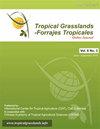澄清柱花草分类中的混淆。2. M.B. Ferreira & Sousa Costa vs. s capitata Vogel和s bracteata Vogel
IF 0.7
4区 农林科学
Q3 AGRICULTURE, DAIRY & ANIMAL SCIENCE
引用次数: 1
摘要
大柱头草(Stylosanthes macrocephala)于1977年被列为新种,已成为一种具有重要经济价值的牧草豆科植物。最近有人声称它与S. capitata属同源,后者也是一种重要的经济物种。本文驳斥了这种同义性,并总结了形态学描述、遗传学研究和细胞学证据,表明二倍体大头蛇应该被视为一个独立的物种,甚至可能是四倍体大头蛇的祖先。还讨论了早期与苞片蒿的混淆。本文章由计算机程序翻译,如有差异,请以英文原文为准。
Clearing confusion in Stylosanthes taxonomy. 2. S. macrocephala M.B. Ferreira & Sousa Costa vs. S. capitata Vogel and S. bracteata Vogel
Stylosanthes macrocephala was described as a new species in 1977 and has become an economically important pasture legume. It has recently been claimed to be conspecific with S. capitata, also an economically important species. This paper refutes this synonymization and summarizes morphological descriptions as well as genetic studies and cytological evidence indicating that diploid S. macrocephala should be considered a separate species, even being a likely progenitor of tetraploid S. capitata. Early confusion with S. bracteata is also discussed.
求助全文
通过发布文献求助,成功后即可免费获取论文全文。
去求助
来源期刊

Tropical Grasslands-Forrajes Tropicales
Agricultural and Biological Sciences-Agronomy and Crop Science
CiteScore
1.60
自引率
0.00%
发文量
36
审稿时长
16 weeks
期刊介绍:
The Journal publishes, in English or Spanish, Research Papers and Short Communications on research and development, as well as contributions from practitioners (Farmer Contributions) and Review Articles, related to pastures and forages in the tropics and subtropics. There is no regional focus; the information published should be of interest to a wide readership, encomprising researchers, academics, students, technicians, development workers and farmers.
In general, the focus of the Journal is more on sown (''improved'') pastures and forages than on rangeland-specific aspects of natural grasslands, but exceptions are possible (e.g. when a submission is relevant for a particularly broad readership in the pasture and forage science community).
The Journal will also consider the occasional publication of associated, but closely related, research in the form of an additional scientific communication platform [e.g. a re-make of the former Genetic Resources Communication series of the former Division of Tropical Crops and Pastures of the Commonwealth Scientific and Industrial Research Organisation (CSIRO), Australia].
Areas of particular interest to the Journal are:
Forage Genetic Resources and Livestock Production[...]
Environmental Functions of Forages[...]
Socio-economic Aspects[...]
Topics within the aforementioned areas may include: Diversity evaluation; Agronomy; Establishment (including fertilization); Management and utilization; Animal production; Nutritive value; Biotic stresses (pests and diseases, weeds); Abiotic stresses (soil fertility, water, temperature); Genetics and breeding; Biogeography and germplasm collections; Seed production; Ecology; Physiology; Rhizobiology (including BNF, BNI, mycorrhizae); Forage conservation; Economics; Multilocational experimentation; Modelling.
 求助内容:
求助内容: 应助结果提醒方式:
应助结果提醒方式:


